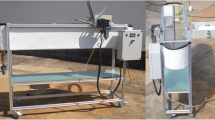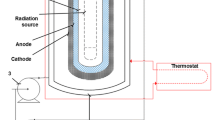Abstract
For the first time, the fungicide thiabendazole (TBZ) and its transformation products (TPs) were monitored under outdoor conditions, using natural sunlight (NSL) as a photon source, and the Magnetic Fraction of a low-grade titanium ore (MFTO) as an iron catalyst, in a raceway pond reactor. The TBZ degradation (TBZD) was performed by two systems: solar photo-Fenton-like (MFTO-H2O2-NSL) and solar photo Fe/NaOCl (MFTO-NaOCl-NSL), both treatments were carried out using distilled water spiked with 1 mg/L TBZ under natural sunlight. The TPs were determined by a highly sensitive method based on liquid chromatography (LC) coupled to hybrid quadrupole time-of-flight mass spectrometry (QTOF-MS). The TBZD results of four TPs were detected throughout the MFTO-NaOCl-NSL operation, and only two of them remained after t = 75 min. While, twelve TPs were formed during the TBZD in the MFTO-H2O2-NSL system, and all reached stable concentrations after t = 180 min. That might be related with a faster degradation when NaOCl was used as an oxidant instead of H2O2. Thus, 80% of TBZD was achieved at t = 40 and 240 min by the MFTO-NaOCl-NSL and MFTO-H2O2-NSL systems, respectively. Consequently, the pseudo-first-order kinetic constant of MFTO-NaOCl-NSL (0.059 min−1) was almost tenfold higher than the value obtained by MFTO-H2O2-NSL (0.006 min−1). The results obtained emphasize that the use of NaOCl as an alternative oxidant to H2O2, not only improves the reaction kinetics but also reduces the number of TPs at the end of the degradation process.




Similar content being viewed by others
References
Dumancas GG, Hikkaduwa Koralege RS, Mojica ERE et al (2014) Thiabendazole. Encycl Toxicol 4:533–536. https://doi.org/10.1016/B978-0-12-386454-3.01173-8
Schirra M, D’Aquino S, Cabras P, Angioni A (2011) Control of postharvest diseases of fruit by heat and fungicides: efficacy, residue levels, and residue persistence. a review. J Agric Food Chem 59:8531–8542. https://doi.org/10.1021/jf201899t
Peng XX, Bao GM, Zhong YF et al (2021) Highly sensitive and rapid detection of thiabendazole residues in oranges based on a luminescent Tb3+-functionalized MOF. Food Chem 343:128504. https://doi.org/10.1016/j.foodchem.2020.128504
USEPA (2002) R.E.D. FACTS thiabendazole and salts
Martín-de-Lucía I, Gonçalves SF, Leganés F et al (2019) Combined toxicity of graphite-diamond nanoparticles and thiabendazole to Daphnia magna. Sci Total Environ 688:1145–1154. https://doi.org/10.1016/j.scitotenv.2019.06.316
Ramírez-Morales D, Pérez-Villanueva ME, Chin-Pampillo JS et al (2021) Pesticide occurrence and water quality assessment from an agriculturally influenced Latin-American tropical region. Chemosphere. https://doi.org/10.1016/j.chemosphere.2020.127851
Fang W, Peng Y, Muir D et al (2019) A critical review of synthetic chemicals in surface waters of the US, the EU and China. Environ Int 131:104994. https://doi.org/10.1016/j.envint.2019.104994
Sánchez Peréz JA, Carra I, Sirtori C et al (2014) Fate of thiabendazole through the treatment of a simulated agro-food industrial effluent by combined MBR/Fenton processes at μg/L scale. Water Res 51:55–63. https://doi.org/10.1016/j.watres.2013.07.039
Ibarz R, Garvín A, Aguilar K, Ibarz A (2016) Kinetic study and modelling of the UV photo-degradation of thiabendazole. Food Res Int 81:133–140. https://doi.org/10.1016/j.foodres.2015.12.014
Carra I, Sirtori C, Ponce-Robles L et al (2015) Degradation and monitoring of acetamiprid, thiabendazole and their transformation products in an agro-food industry effluent during solar photo-Fenton treatment in a raceway pond reactor. Chemosphere 130:73–81. https://doi.org/10.1016/J.CHEMOSPHERE.2015.03.001
Sirtori C, Agüera A, Carra I, Sanchéz Pérez JA (2014) Identification and monitoring of thiabendazole transformation products in water during Fenton degradation by LC-QTOF-MS. Anal Bioanal Chem 406:5323–5337. https://doi.org/10.1007/s00216-014-7942-1
García-Estrada R, Esteban García B, Ramírez-Zamora RM, Sánchez Pérez JA (2020) Micropollutant degradation by the heterogeneous solar photo-Fenton process at circumneutral PH using copper slag. J Water Process Eng. https://doi.org/10.1016/j.jwpe.2020.101562
Rizzo L, Malato S, Antakyali D et al (2019) Consolidated vs new advanced treatment methods for the removal of contaminants of emerging concern from urban wastewater. Sci Total Environ 655:986–1008. https://doi.org/10.1016/J.SCITOTENV.2018.11.265
Carra I, Santos-Juanes L, Gabriel F et al (2014) New approach to solar photo-Fenton operation. Raceway ponds as tertiary treatment technology. J Hazard Mater 279:322–329. https://doi.org/10.1016/j.jhazmat.2014.07.010
Sánchez-Pérez JA, Arzate S, Soriano-Molina P et al (2020) Neutral or acidic pH for the removal of contaminants of emerging concern in wastewater by solar photo-Fenton? A techno-economic assessment of continuous raceway pond reactors. Sci Total Environ 736:139681. https://doi.org/10.1016/j.scitotenv.2020.139681
González-Bahamón LF, Hoyos DF, Benítez N, Pulgarín C (2011) New Fe-immobilized natural bentonite plate used as photo-Fenton catalyst for organic pollutant degradation. Chemosphere 82:1185–1189. https://doi.org/10.1016/j.chemosphere.2010.11.071
Behin J, Akbari A, Mahmoudi M, Khajeh M (2017) Sodium hypochlorite as an alternative to hydrogen peroxide in Fenton process for industrial scale. Water Res 121:120–128. https://doi.org/10.1016/j.watres.2017.05.015
Folkes LK, Candeias LP, Wardman P (1995) Kinetics and mechanisms of hypochlorous acid reactions. Arch Biochem Biophys 323:120–126. https://doi.org/10.1006/abbi.1995.0017
Armstrong DA, Huie RE, Koppenol WH et al (2016) Standard electrode potentials involving radicals in aqueous solution: inorganic radicals (IUPAC technical report). Dep Chem Biochem. https://doi.org/10.1515/ci-2016-0217
Guo K, Wu Z, Shang C et al (2017) Radical chemistry and structural relationships of PPCP degradation by UV/chlorine treatment in simulated drinking water. Environ Sci Technol 51:10431–10439. https://doi.org/10.1021/acs.est.7b02059
Portilla-Sangabriel M, Arzate S, Macías-Vargas JA, Ramírez-Zamora RM (2020) Assessment of the use of NaClO as an alternative to H2O2 in the oxidant-titanium ore-simulated solar light system for thiabendazole degradation. Top Catal. https://doi.org/10.1007/s11244-020-01388-8
Wang C, Moore N, Bircher K et al (2019) Full-scale comparison of UV/H2O2 and UV/Cl2 advanced oxidation: the degradation of micropollutant surrogates and the formation of disinfection byproducts. Water Res 161:448–458. https://doi.org/10.1016/J.WATRES.2019.06.033
Macías-Vargas J-A, Zanella R, Ramírez-Zamora R-MM et al (2020) Degradation of ciprofloxacin using a low-grade titanium ore, persulfate and artificial sunlight. Environ Sci Pollut Res 27:28623–28635. https://doi.org/10.1007/s11356-020-08293-3
Macías-Vargas JA, Campos-Mañas MC, Agüera A et al (2021) Enhanced activated persulfate oxidation of ciprofloxacin using a low-grade titanium ore under sunlight: influence of the irradiation source on its transformation products. Environ Sci Pollut Res. https://doi.org/10.1007/s11356-020-11564-8
Tabla Vázquez CG (2016) Hydrogen production from formic acid present in water by heterogeneous photocatalysis with natural minerals of iron and titanium oxides (spanish). The National Autonomous University of Mexico (UNAM)
Committee for Risk Assessment (2017) Opinion proposing harmonised classification and labelling at EU level of thiabendazole (ISO); 2-(thiazol-4-yl) benzimidazole. Helsinki, Finland
Roca Jalil ME, Vieira RS, Azevedo D et al (2013) Improvement in the adsorption of thiabendazole by using aluminum pillared clays. Appl Clay Sci 71:55–63. https://doi.org/10.1016/j.clay.2012.11.005
Gamba M, Olivelli M, Lázaro-Martínez JM et al (2017) Thiabendazole adsorption on montmorillonite, octadecyltrimethylammonium- and Acremonium sp.-loaded products and their copper complexes. Chem Eng J 320:11–21. https://doi.org/10.1016/j.cej.2017.03.034
Jiménez M, Ignacio Maldonado M, Rodríguez EM et al (2015) Supported TiO2 solar photocatalysis at semi-pilot scale: degradation of pesticides found in citrus processing industry wastewater, reactivity and influence of photogenerated species. J Chem Technol Biotechnol 90:149–157. https://doi.org/10.1002/jctb.4299
Wang H, Li X, Zhao X et al (2022) A review on heterogeneous photocatalysis for environmental remediation: from semiconductors to modification strategies. Chin J Catal 43:178–214. https://doi.org/10.1016/S1872-2067(21)63910-4
Xia D, He H, Liu H, Wang Y, Zhang Q, Li Y, Lu A, He C, Wong PK, Xia D, He H et al (2018) Persulfate-mediated catalytic and photocatalytic bacterial inactivation by magnetic natural ilmenite. Appl Catal B 238:70–81. https://doi.org/10.1016/j.apcatb.2018.07.003
Kong X, Jiang J, Ma J et al (2016) Degradation of atrazine by UV/chlorine: efficiency, influencing factors, and products. Water Res 90:15–23. https://doi.org/10.1016/j.watres.2015.11.068
Georgiou D, Melidis P, Aivasidis A, Gimouhopoulos K (2002) Degradation of azo-reactive dyes by ultraviolet radiation in the presence of hydrogen peroxide. Dye Pigment 52:69–78. https://doi.org/10.1016/S0143-7208(01)00078-X
Nowell LH, Hoigni JURG (1992) Photolysis of aqueous chlorine at sunlight. Production 26:593–598
Neyens E, Baeyens J (2003) A review of classic Fenton’s peroxidation as an advanced oxidation technique. J Hazard Mater 98:33–50. https://doi.org/10.1016/S0304-3894(02)00282-0
Rivas Ibáñez G, Esteban B, Ponce-Robles L et al (2015) Fate of micropollutants during sewage sludge disintegration by low-frequency ultrasound. Chem Eng J 280:575–587. https://doi.org/10.1016/j.cej.2015.06.010
Murthy NBK, Moza PN, Hustert K et al (1996) Photolysis of thiabendazole in aqueous solution and in the presence of fulvic and humic acids. Chemosphere 33:1915–1920. https://doi.org/10.1016/0045-6535(96)00313-X
Calza P, Baudino S, Aigotti R et al (2003) Ion trap tandem mass spectrometric identification of thiabendazole phototransformation products on titanium dioxide. J Chromatogr A 984:59–66. https://doi.org/10.1016/S0021-9673(02)01837-X
Ji Y, Zhou L, Ferronato C et al (2013) Degradation of sunscreen agent 2-phenylbenzimidazole-5-sulfonic acid by TiO2 photocatalysis: kinetics, photoproducts and comparison to structurally related compounds. Appl Catal B 140–141:457–467. https://doi.org/10.1016/j.apcatb.2013.04.046
Acknowledgements
Melisa Portilla Sangabriel acknowledges CONACYT for her Ph.D. scholarship. Sandra Arzate thanks DGAPA for her postdoctoral fellow. The authors acknowledge the financial support granted by PAPIIT, UNAM (IT100921). A. Agüera and J.A. Sánchez Pérez are grateful to the Spanish Ministry of Science and Innovation, AEI, and the European Regional Development Fund (ERDF) for funding as part of the NAVIA Project (PID2019-110441RB-C31)
Author information
Authors and Affiliations
Corresponding author
Ethics declarations
Conflict of interest
Authors wish to confirm that there are no known conflict of interest associated with this publication and there has been no significant financial support for this work that could have influenced its outcome.
Additional information
Publisher's Note
Springer Nature remains neutral with regard to jurisdictional claims in published maps and institutional affiliations.
Rights and permissions
About this article
Cite this article
Portilla-Sangabriel, M., Martínez-Piernas, A.B., Agüera, A. et al. Degradation of Thiabendazole and Its Transformation Products by Two Photo-Assisted Iron-Based Processes in a Raceway Pond Reactor. Top Catal 65, 1113–1127 (2022). https://doi.org/10.1007/s11244-022-01638-x
Accepted:
Published:
Issue Date:
DOI: https://doi.org/10.1007/s11244-022-01638-x




